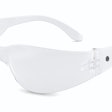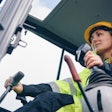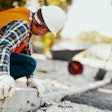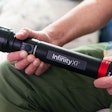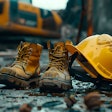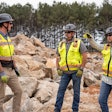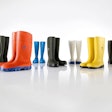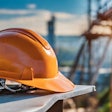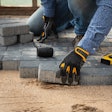
It’s that time of the year again where in many parts of the country, construction workers are layering up for warmth to work in cold environments.
Heated jackets and heated vests provide an option for doing so. They are typically manufactured to be thin and lightweight but designed and manufactured to last longer than standard jackets.
Workers depend on them to maintain body temperature despite outdoor temperatures and help to increase comfort and work efficiency. Just as with other construction work apparel, some companies manufacture heated jackets and vests to fit women workers as well.
Design and Operation
Heated jackets and vests are typically battery powered. A heated jacket or vest features a pocket dedicated to a battery holder for a lithium-ion battery. It connects to a cable entering the jacket lining. The heating element is activated through a power button and cycles through the heat settings, indicated by lights on the battery holder or on the outside of the jacket.
There are even some battery holders that include USB ports to charge phones and other electronics. Heated jackets and vests are typically made of carbon fiber, steel plates, or Graphene – a single layer of carbon atoms in a hexagonal lattice for efficiency and durability.
Many of the jackets and vests have an outer layer made of polyester, which warms up quickly and adapts to body heat. Waterproof membranes that protect the wires means the panels on heated jackets won’t catch on fire or absorb moisture. While the apparel may be waterproof, most are not intended to be worn in the rain or in wet conditions.
While heated jackets and vests typically derive their heat from power banks or batteries integrated into the lining, other options include chemically heated jackets warmed with single-use packs or heating chemicals or stored-heat apparel that holds gel packs that are microwaved before use.
Some heated jackets and vests come with adjustable heat levels. The length of the time the jacket or vest stays heated depends on the voltage of the battery.
Because they are battery powered, heated jackets and vests require access to electricity as they won’t provide the same level of warmth until they are charged again, although extra batteries or fully charged power banks can provide back-up.
The lithium-ion rechargeable battery used in heated jackets and vests also is the same technology used for power tools. For heated jackets and vest, it may be a more reliable power source and provide better performance.
Most heated jackets and vests use batteries of less than 10V, eliminating electrocution risk. The batteries are less than 12V DC with a frequency of 0Hz, addressing high-frequency EMF radiation concerns.
Top Products: Check out this selection of Dewalt heated jackets for construction pros.
Which One is Right for You?
In choosing between wearing a heated jacket or a heated vest, consider coverage, mobility and layering, versatility, temperature control and power source needs. The choice is dictated by the job tasks, working conditions and the need for more mobility.
If comprehensive coverage is sought, a heated jacket will cover the entire upper body. Heated jackets may come with heating elements strategically placed near the back, chest and arms with multiple heat settings enabling the worker wearing it to adjust the temperature to the desired comfort level in each zone.
It is often worn as standalone outerwear or over other clothing layers. Sleeves may limit mobility in work tasks compared to wearing a heated vest with a shirt underneath that enables greater mobility. While a heated vest primarily covers the torso – including the chest and back – it will not provide warmth to the arms, necessitating layers underneath. It may be indicated for workers whose job tasks entail a wider range of motion. Because heated jackets power multiple heating elements, they typically have a larger battery capacity. As such, they may provide longer-lasting heat. The downside: a bulkier battery pack in contrast to a heated vest, which may not offer heat as long as a jacket, but its battery packs are smaller and lighter for heating fewer elements.
Just as with using power tools on the jobsite, it’s important to understand safety precautions when wearing heated apparel; reading the instruction manuals is key. Some heated apparel can be machine-washed; some manufacturers recommend hand washing. Safe storage when not in use is key to the apparel’s functionality and longevity.




